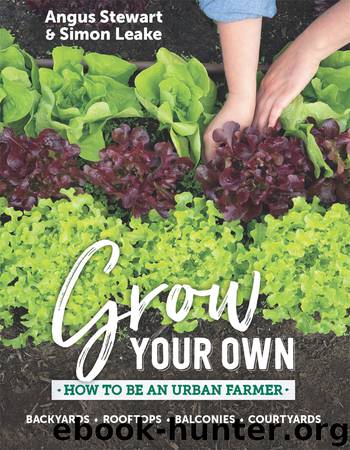Grow Your Own by Angus Stewart

Author:Angus Stewart
Language: eng
Format: epub
Publisher: Allen & Unwin
Published: 2017-05-20T04:00:00+00:00
PROPAGATION BY LAYERING
A handy method for vegetatively propagating species that are hard to strike from cuttings is layering. This is like taking a cutting, except that it is left attached to the mother plant, which continues to nourish it until it has developed its own root system. This method has no special requirements for greenhouses or other environmental controls. Another advantage is that much larger plants can be produced than is possible by cuttings – your layered section can have 30–50 centimetres of growth above the area where the roots are induced to form. By the time it is ready to go into the ground, the new plant will be quite substantial in size.
For most plants, it is best to start the layers off in late autumn or winter, before the plant starts its surge of growth and new root production in spring. There are a couple of particularly useful layering techniques that are successful for a wide variety of plants: simple layering and aerial layering.
Simple layering
This method is most suitable when plants, such as strawberries or raspberries, have branches or shoots that are close to the ground. A long stem is bent down to ground level; its neck is buried, and its tip is left sticking up out of the soil. The stem can be tied to a small stake with an old piece of stocking or similar flexible material to ensure that it stays under the soil. Once it is sufficiently well rooted, the stem can then be removed from the mother plant and potted up, or even planted straight back into the garden.
Another layering option is to follow the same procedure, but bury the stem in a pot filled with coarse potting mix (a 50/50 blend of general-purpose potting mix and either coarse river sand or perlite). This second option is very handy, as it eliminates the possibility of root damage when the layer is eventually removed from the mother plant.
To encourage root formation, make a cut in the part of the stem that is to be buried; this also makes it easier to bend the tip of the stem up. It is also a good idea to mix a generous amount of coconut coir into the soil that is used to backfill around the cut stem. Ensure that the soil does not ever dry out excessively during the root-formation process.
Download
This site does not store any files on its server. We only index and link to content provided by other sites. Please contact the content providers to delete copyright contents if any and email us, we'll remove relevant links or contents immediately.
Turbulence by E. J. Noyes(7942)
The Thirst by Nesbo Jo(6832)
Gerald's Game by Stephen King(4584)
Be in a Treehouse by Pete Nelson(3953)
Marijuana Grower's Handbook by Ed Rosenthal(3623)
The Sprouting Book by Ann Wigmore(3544)
The Red Files by Lee Winter(3368)
The Remains of the Day by Kazuo Ishiguro(3295)
Sharp Objects: A Novel by Gillian Flynn(2958)
Christian (The Protectors Book 1) by L. Ann Marie(2656)
Organic Mushroom Farming and Mycoremediation by Tradd Cotter(2631)
The Culinary Herbal by Susan Belsinger(2433)
Stone Building by Kevin Gardner(2353)
The Starter Garden Handbook by Alice Mary Alvrez(2285)
Lilac Girls by Martha Hall Kelly(2258)
The Unlikely Pilgrimage of Harold Fry by Rachel Joyce(2221)
The Lean Farm Guide to Growing Vegetables: More In-Depth Lean Techniques for Efficient Organic Production by Ben Hartman(2099)
Urban Farming by Thomas Fox(2063)
Backyard Woodland by Josh VanBrakle(1895)
